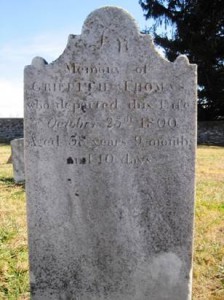 Griffith Thomas' gravestone in the Ebenezer Baptist Church Cemetery, Bluemont, Loudoun County, Virginia
Griffith Thomas' gravestone in the Ebenezer Baptist Church Cemetery, Bluemont, Loudoun County, Virginia
Instead of identifying a person’s date of birth, death certificates and gravestones sometimes identify the deceased person’s age in years, months, and days. But what is the purpose of giving an exact age rather than a birth date, and how is this age determined? Are there any consistent rules for this process?
In Colonial America it was traditional practice to inscribe a tombstone with the deceased’s age in years, months, and days. For example, the cemetery marker for Griffith Thomas was inscribed with the following: “In Memory of Griffith Thomas who departed this life October 25th 1800 Aged 58 years, 9 months and 10 days.”
While it was customary to record a person’s age narratively, it is unlikely that the informant presented this information in that format. Rather, the informant would have provided the clerk/engraver with the deceased’s date of birth, and the specific age would be calculated for the gravestone. To help determine the date of birth of your ancestors, I include several links to tombstone calculators below:
- http://www.progenealogists.com/birthfromdeath.htm
- http://www.searchforancestors.com/utility/birthday.html
- http://www.ovs-genealogy.com/tools/free_birthdate_calculator_calculates_birth_day.shtml
Nineteenth and twentieth century death records also recorded the age at death, but this practice was not just customary. Instead, these modern death records provided statistical information for the nation’s politicians and doctors, as well as for life insurance companies. For example, in a Report of the Vital Statistics of the United States, made to the Mutual Life Insurance Company of New York, the author reported that the average age at death of the residents of Plympton, Plymouth Colony, Massachusetts, between the years 1812 and 1842 was 40 years, 10 months, 25 15/24 days. I have included a link to the 1857 report here.
Because the death information was originally recorded using age in years, months, and days, the above statistical information would have been easier to calculate. Therefore, some (but not all) town, counties, and states recorded deaths using this format.
Share this:
About Lindsay Fulton
Lindsay Fulton joined the Society in 2012, first a member of the Research Services team, and then a Genealogist in the Library. She has been the Director of Research Services since 2016. In addition to helping constituents with their research, Lindsay has also authored a Portable Genealogists on the topics of Applying to Lineage Societies, the United States Federal Census, 1790-1840 and the United States Federal Census, 1850-1940. She is a frequent contributor to the NEHGS blog, Vita-Brevis, and has appeared as a guest on the Extreme Genes radio program. Before, NEHGS, Lindsay worked at the National Archives and Records Administration in Waltham, Massachusetts, where she designed and implemented an original curriculum program exploring the Chinese Exclusion Era for elementary school students. She holds a B.A. from Merrimack College and M.A. from the University of Massachusetts-Boston.View all posts by Lindsay Fulton →